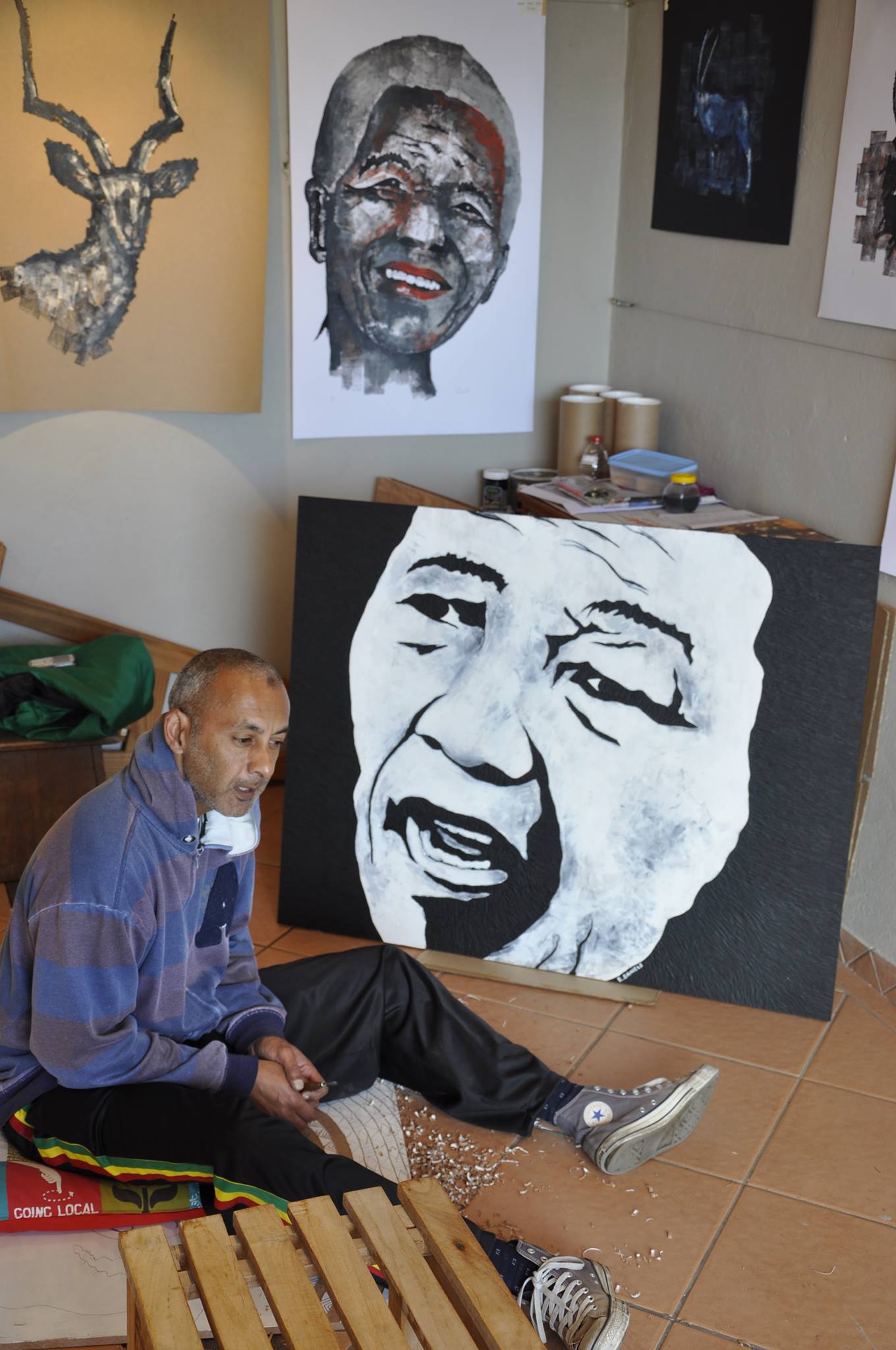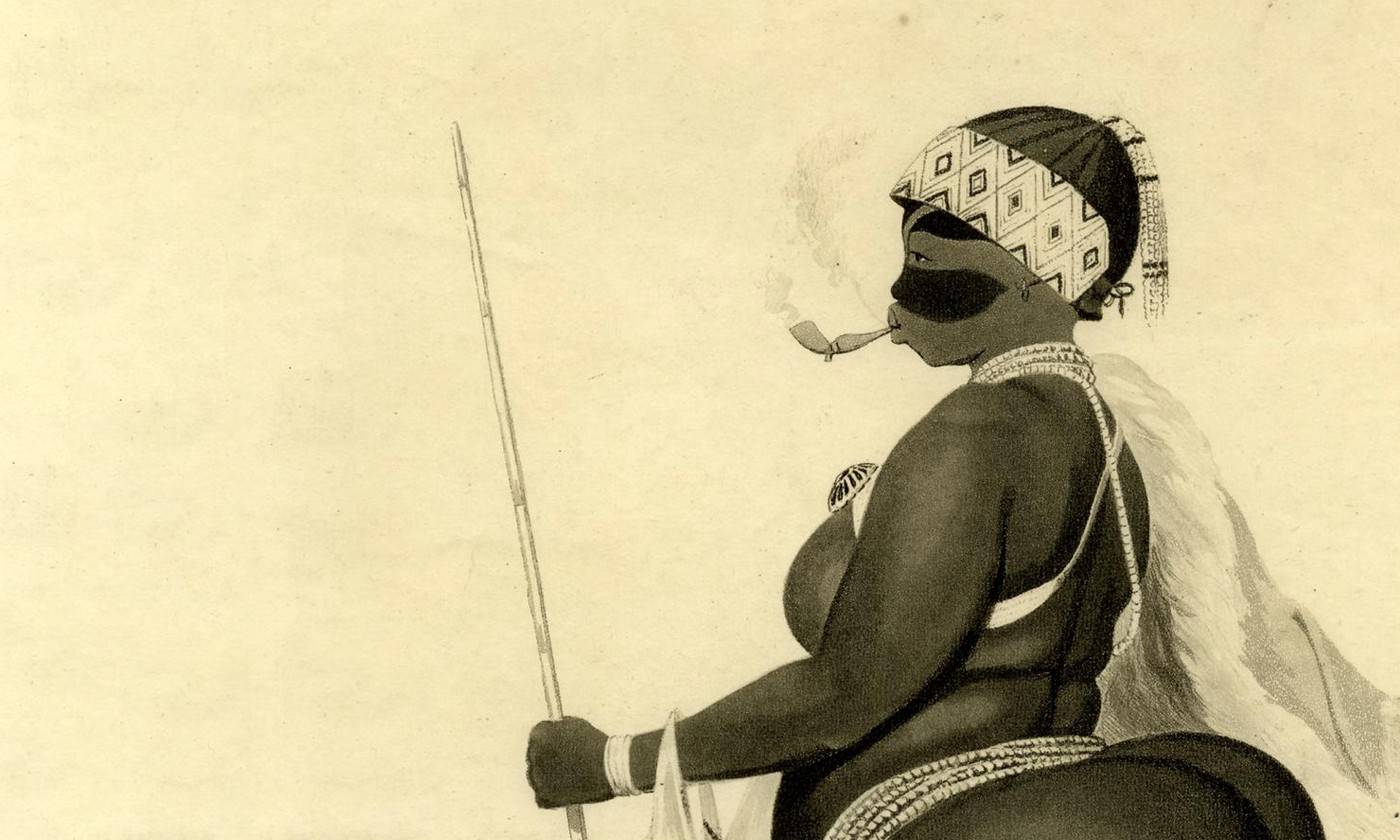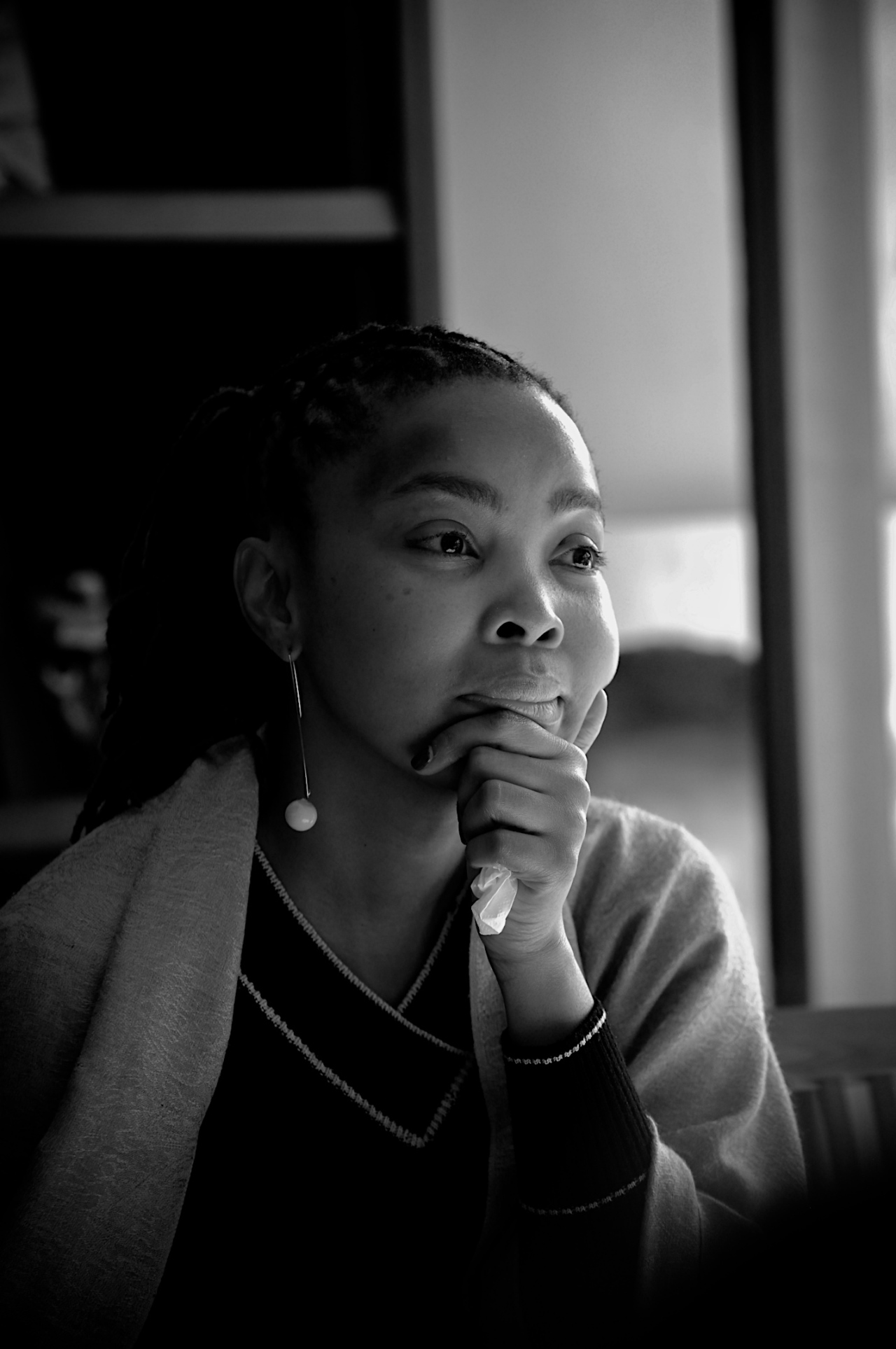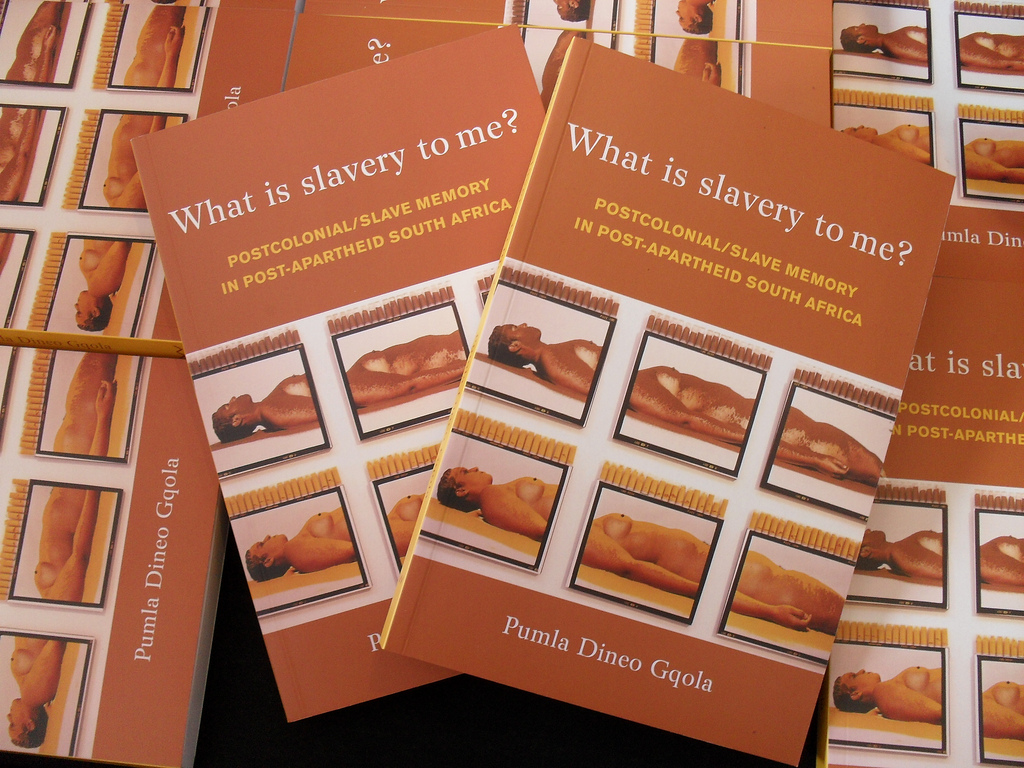*This essay forms part of Bubblegum’s Collaboration with Bag Factory and their visiting curator from Uganda, EM Mirembe. Reader, writer and PhD candidate Mapule Mohulatsi reads R. Daniels‘ artwork The Dreamer, in Medindi Manor with meditations on wakefulness.
This is about a sleeping, possibly dead, black woman I met at a Cape Town lodge where the stairs creaked, and the antique bathtubs had taps that drooped like haunting gold stones with the promise of water. A bathtub with legs golden and skin so white it looked polished.
This essay has plenty of dark crevices and ghosts in almost every corner, be careful.
There are interruptions by the Giant Kingfisher, 1652, Gabeba Baderoon and a dead mother who seems to be making quite an appearance in almost everything I write; this time I’m blaming it on Jay Electronica’s “A.P.I.D.T.A.” Before we meet The Dreamer, I, as always, divert into a little anecdote about that one time I slept and woke to a plethora of white butterflies at my feet in the bus, or was it at home?
These could possibly be two stories. In the essay some fiction enmeshes with the real “wakeful” stuff of the everyday. What is fiction and what is real is for you to decide. Like Andre 3000, “I tinker, I tinker a lot.” I sleep and I wake. I ponder death and wakefulness. There really is no chronology, at the heart of it, this essay only has one story. This story is about The Dreamer; the dead, possibly sleeping, black woman I met at a Cape Town lodge where the antique stairs creaked, and the bathtubs stood like the haunting ghouls of remembrance.

Medindi Manor
September 2017. Medindi Manor.
I am staying at an idyllic lodge in Cape Town, Rosebank with friends. We are enthralled at our rooms which are, Cape Town like, which is aesthetically pleasing, refreshing even. The rooms have antique furniture, incense, and watercolour paintings of indigenous birds, flora, fauna, and people. The Giant Kingfisher with its hard exterior is captured with the zealous precision of an explorer’s obsession with detail — anthropological detail — detailing that assumes, consumes, and replicates. The bird stares down at us with an intensity the artist must have mulled over, surely.
The Giant Kingfisher also raises questions of erasure: the absence of detail, or even detailing as erasure. The artist or maybe even an archivist has italicised the words ‘Wild Art’ below the threatening Giant Kingfisher. In her book Regarding Muslims: From slavery to post-apartheid, Gabeba Baderoon writes that the colonialist gaze on art “rendered the occupied territory into an object that could be understood, and therefore naturalised imperialism’s assertion of ownership over what it proclaimed to be an ‘uninscribed’ land[/body]”.
The naming of the Giant Kingfisher is already an inscription that renders the name it had before the arrival of the artist insignificant, if not non-existent. The inscription below the threatening Kingfisher and the detailing of it as ‘Wild Art’ speaks directly to the occupation of territory and the power of detailing. Here, the detailer’s dream is truth. To echo Baderoon, for the artist “the landscape [has] refused to be blank and indescribable, denying the fantasy of a new Eden.”

Portrait of Gabeba Baderoon
The particular gaze of both the artist and the archivist (as well as the lodge) make it seem as if the Giant Kingfisher is being seen for the first time. It, as Baderoon puts it, “forces a newness into a world that [is] not new”; I guess that’s why it is important for Medindi Manor to include it in their collection, it adds an aesthetic value that is so particular to the Cape — it screams, again from Baderoon: “This is where the world begins, this is how it began, and this is whom it began with”.
Desire, anxiety, excitement, and disgust lead us to explore the rest of Medindi Manor and as if led by the Fates, Thando and I speak of the colonial manor and how it is highly possible that black women were raped there. That is when she cuts our conversation, that’s how we meet her, or she meets us — on the second floor of the main house, on the wall opposite Leyya’s room. The Dreamer. She is sprawled on what appears to be a knitted mat, the mat has patterns of lines and zigzags, she is naked, black, big breasted, a blank (black) face; her arms outstretched, her rib cage is visible — signifying either her hunger or her likeness to a starved and caged animal.
There is a dream catcher that hangs above her. This is uncomfortable. Firstly, yes, slave women, black women, are being raped here. Secondly, Hartman’s Venus in Two Acts comes to mind: the dead brought to life, only this is, at first, an insult and a romanticisation — this is Black Venus — the Terrible Beauty — was she ever even allowed to dream? Of what? With whom? It’s almost as if we are meant to know what she dreams of — food, freedom, clothing, shoes, her babies…The dream catcher might also signify that her dreams are being stolen from her. Funny how when we think about Sarah Baartman, we are more inclined to think of her captivity, never of her as a willing subject who was promised fame and thus had followed her dream, right into their cage.

Portrait of R. Daniels
it is months later
In this dream it is months before her death. In the dream I am sitting on a low wall. In the dream I recognise that the wall is that of the house that she built, a house, my home, that she had, until her last breath, furnished and worked on non-stop. My legs and feet are the only things that are of my body and visible in the dream. The upper part of my body is absent from the dream. This is a wall at my family house before it became tall and decorated. So it is low. In the dream my age is a secret, but I can tell that I am not as old as I am now.
My dangling legs and feet are apart from each other, each hanging on a side of the low wall. Despite the lowness of the wall, my feet are not touching the ground. Below is not dust, but white butterflies. White butterflies of various sizes, but the same white. A striking and brilliant white. They are everywhere, surrounding the wall. All of them are attempting to climb onto my dangling feet; their touch is soft, and nervous.

On the morning of her death, months later, I dream that she is watering the garden, but it is not water that sprouts from the hosepipe rather an army of white butterflies. She tells me to quickly go and call my cousin. Quick! I wake. Minutes later my cousin comes to us (my brothers and I) to relay the news of our mother’s death. The hospital called my father who was not bold enough to let us know himself. In Japanese mythology the white butterfly represents the soul of the departed.
right into their cage
She is the known unknown, we do not need to see her face, and she does not need to have a face, because we know who she is. Black Venus, the Terrible Beauty. This is the notion that Saidiya Hartman conveys about Black Venus, that: “[…] no one recorded her name or recorded the things she said, or observed that she refused to have anything said at all. Hers is an untimely story told by a failed witness.

Portrait of Saidiya Hartman
It would be centuries before she would be allowed to “try her tongue””. In the case of R. Daniels, a Cape “Coloured” artist, he has refused entirely to give her a tongue, let alone a face, not without intention. It is hysterical even that Medindi Manor is the final resting place for the art piece (first removed from the University of Cape Town’s collection during Fees Must Fall), and The Dreamer, its corpse, held captive in a crypt of historical dysfunction.
Black Venus in plural exists in post-apartheid South African art and scholarship. Medindi Manor is replicating a scene, a story, a dream, so particular to the South African imaginary that I, whenever I write of The Dreamer, question whether this memory is a problem, or if I am the problem? For Medindi Manor, this aesthetic is fitting, as in so many other scenarios like museums and art exhibitions as well as t-shirts and profile pictures in memory of The Terrible Beauty.
But the most striking feature of this particular rehearsal by Daniels, for me, is that it opens up the realm of sleep and dreaming and yet — still cannot veer away from the wakeful reality of The Dreamer. Even in the realm of sleep she cannot escape, or dream, or us, for her. The Dreamer, I believe, asks that we consider what we do with sleep and its fall, especially where Morrison’s notion of rememory is concerned. To sleep and to dream is not the impossibility of time but a stretching, a furthering, a walking of time; and thus history.

Portrait of Pumla Dineo Gqola
Yes, it is possible to sleep twice and to wake twice because as Jean-Luc Nancy in her philosophy on sleep explains “at every instant the dreamer thinks he is in the waking world and knows he is in the dreamworld, whose simultaneities, compossibilities, confusions do not escape him but also do not surprise him enough to make him emerge from the dream”. In the fall of sleep, history (or rather one’s reality which later becomes history), is in suspension and thus everything else is also possible.
“I fall asleep and at the same time I vanish as ‘I’”, Nancy writes. Hence, in sleep or maybe even in death, rhythm, regularity and being operate from a different timespace. I am now interested, because of the huge awakening (haha!) from Jean-Luc Nancy’s philosophy to “penetrate [into] monumental memory”, that being history and its artefact through the fall, and the fact, of sleep.

The Dreamer by R. Daniels is a figure that I meet as if she is in storage, kept safe, treasured, at home. Archived. Daniels is in the act of disrupting an archive, yet his disruption also relies on visual representations that continue to sculpt Black Venus as an unchanging sexual stereotype. Her facelessness and namelessness are accounted for by her blackness — through and by her blackness, we know who she is. Her story is, as Hartman relays, “not about her, but rather about the violence, excess, mendacity, and reason that seized hold of her life”.
Where Black Venus is concerned the exteriors become more important than the interiors – the exterior being her body, the interior being her personal history, her secrets, her favourite colour, why the sound of a beehive reminds her of a time when…why she lies about her shoe size, whom she loves, how she loves, and the reasons why she prefers walking over buses, her dreams, anything, small things. In this rehearsal, staged at Medindi Manor, she remains in the crypt that Hartman evokes, “a death sentence, a tomb, a display of the violated body”.
The black facelessness performs the function of unifying experiences as well as a worlding of the black female body. Yet, it also takes away personhood, and individual humane silences. Small things matter too. Is The Dreamer aka Black Venus aka The Veiled Woman a vivid and honest experience? I think not, rather it qualifies as a representation that has been worlded and worlds the black female body.

Medindi Manor
Vivid? Yes; a vividness that is now a genre of representation in which raced and gendered depictions of her are often normalised and ritualised. So yes, just as Pumla Gqola writes in her What is Slavery to Me?: “It is important that we remember her, but it is not necessary for us to have specific details projected or historically verified in order for this memory to work”.
i’ll tell you what, it’s not drowning if you didn’t die.
Mapule Mohulatsi is a reader and writer from Johannesburg, South Africa. She’s also a PhD candidate in the department of African Literature at the University of the Witwatersrand. She is a fellow in the Oceanic Humanities for the Global South, a research project based at WiSER, also at the University of the Witwatersrand.

Portrait of Mapule Mohulatsi



















































